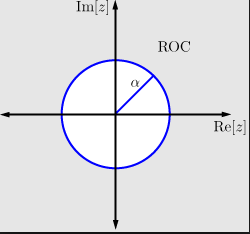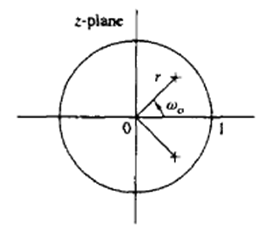1. What are the values of z for which the value of X(z)=0?
A. Poles
B. Zeros
C. Solutions
D. None of the mentioned
2. What are the values of z for which the value of X(z)=∞?
A. Poles
B. Zeros
C. Solutions
D. None of the mentioned
3. If X(z) has M finite zeros and N finite poles, then which of the following condition is true?
A. |N-M| poles at origin(if N>M)
B. |N+M| zeros at origin(if N>M)
C. |N+M| poles at origin(if N>M)
D. |N-M| zeros at origin(if N>M)
4. If X(z) has M finite zeros and N finite poles, then which of the following condition is true?
A. |N-M| poles at origin(if N < M)
B. |N+M| zeros at origin(if N < M)
C. |N+M| poles at origin(if N < M)
D. |N-M| zeros at origin(if N < M)
5. Which of the following signals have a pole-zero plot as shown below?

A. a.u(n)
B. u(an)
C. anu(n)
D. none of the mentioned
6. Which of the following signals have a pole-zero plot as shown below?(Let M=8 in the figure)
A. x(n)=an, 0≤n≤8 =0, elsewhere
B. x(n)=an, 0≤n≤7 =0, elsewhere
C. x(n)=a-n, 0≤n≤8 =0, elsewhere
D. x(n)=a-n, 0≤n≤7 =0, elsewhere
7. The z-transform X(z) of the signal x(n)=anu(n) has:
A. One pole at z=0 and one zero at z=a
B. One pole at z=0 and one zero at z=0
C. One pole at z=a and one zero at z=a
D. One pole at z=a and one zero at z=0
8. What is the nature of the signal whose pole-zero plot is as shown?

A. Rising signal
B. Constant signal
C. Decaying signal
D. None of the mentioned
9. What are the values of z for which the value of X(z)=0?
A. Poles
B. Zeros
C. Solutions
D. None of the mentioned
10. If Y(z) is the z-transform of the output function, X(z) is the z-transform of the input function and H(z) is the z-transform of the system function of the LTI system, then H(z)=?
A. \(\frac{Y(z)}{X(z)}\)
B. \(\frac{X(z)}{Y(z)}\)
C. Y(z).X(z)
D. None of the mentioned
